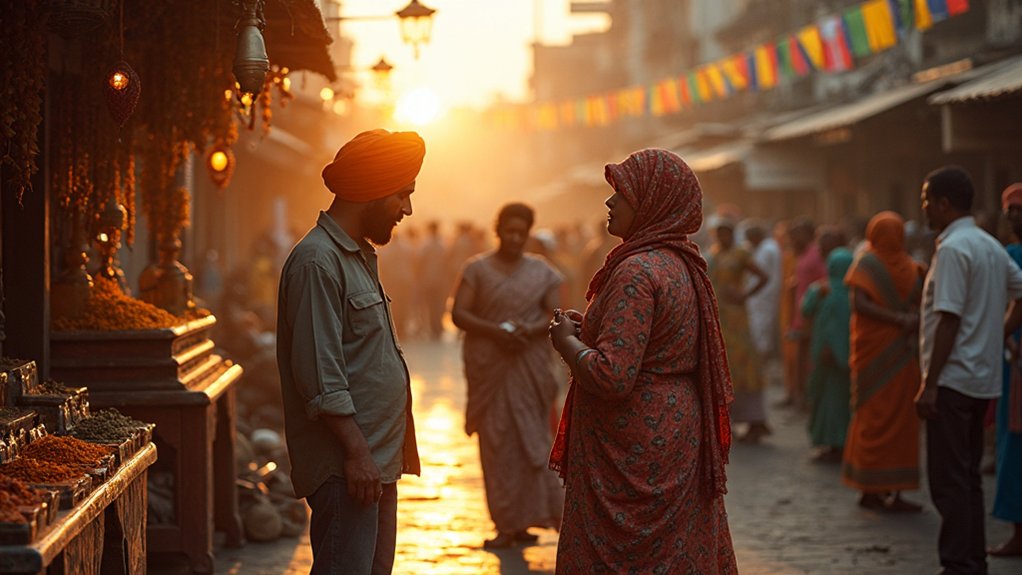
How did Byzantine culture and religion spread in Eastern Europe
Just how Byzantine culture and religion subtly transformed Eastern Europe reveals a fascinating blend of faith, politics, and innovation that shaped history.

You encounter religion through culture first, through language, food, stories, and rituals that define what is sacred and why it matters. Culture shapes how you understand religion, influencing how you interpret holy texts and practice faith every day. At the same time, religion guides cultural norms, ethics, and community bonds. Together, culture and religion build identity, explain life’s joys and challenges, and mark time through festivals and important rites. Understanding the connection between culture and religion helps deepen your appreciation of both spirituality and faith in daily life.

Although culture and religion often overlap, it’s important to understand their differences. Culture is the shared set of values, beliefs, practices, and norms that shape how a group lives. Religion, on the other hand, is a system of beliefs, rituals, and moral teachings centered on the sacred or a higher power.
When exploring how culture and religion connect, we see that cultural contexts influence religious meanings, while religious commitments help reinforce cultural identities.
You see culture shaping how you interpret religion, celebrate religious rituals, and express your spiritual faith day to day. At the same time, religion influences your moral codes, traditions, and community norms. Together, culture and religion create a powerful connection that shapes what you believe and how you live your spiritual life.
Even though religions often present timeless truths, culture plays a key role in shaping religious beliefs and practices. People learn religion through their family, elders, and community, absorbing interpretations influenced by language, history, and local traditions.
Religious beliefs and practices are expressed through culturally influenced rituals such as dress codes, food customs, music, and styles of worship. Additionally, sacred texts are understood through cultural perspectives, which shape the meaning, symbolism, and acceptable behaviors within the religion.
This cultural influence creates unique yet coherent expressions of religion across different communities. Understanding how culture shapes religious beliefs and practices helps deepen our appreciation of spirituality worldwide.
Religion plays a powerful role in shaping cultural norms and traditions around the world. From moral codes to family rituals, religion influences the way communities live and celebrate.
Religious calendars help organize time, while dietary rules shape what people eat. Dress codes based on religious beliefs define modesty, and important rites of passage like birth, marriage, and death are marked by spiritual ceremonies.
You see how religion often anchors a community’s moral compass, shaping what you call right and wrong. Religion guides daily choices—honesty, charity, duty—and sets expectations for behavior in families, schools, and workplaces. As these religious values spread, they build social structures that organize leadership, cooperation, and care for the vulnerable.
Religion plays a crucial role as a foundation for cultural values, deeply influencing everyday life and social structures. Through religion, you inherit important moral teachings, rituals, and stories that help define right and wrong, establish duties, and support authority.
These cultural values rooted in religion are reflected in laws, family roles, charity, and conflict resolution. Additionally, religious festivals, worship, and community service strengthen social bonds.
Even in modern times, when secular ideas grow stronger, religion and its ethical teachings continue to shape your decisions and community expectations.
Across societies, major religions deeply influence local cultures, shaping unique spiritual experiences and traditions. Major religions like Christianity, Islam, Hinduism, and Buddhism grow in diverse ways, blending with cultural customs to create rich, living faiths.
For example, Christianity often incorporates African rhythms in worship, while Islam affects community life through zakat practices. Hinduism inspires colorful art and festivals in India, and Buddhism promotes social harmony in East Asia.
Understanding major religions helps us appreciate shared spiritual values alongside distinct languages, cuisines, music, and attire that define cultural expressions of faith. Exploring major religions reveals how spirituality and culture intertwine to enrich human experience worldwide.
Cultural adaptation within religions shows how faith traditions can blend with local customs in meaningful ways. For example, cultural adaptation within religions is seen when Christianity mixes with Andean rituals in Peru, or when Islam adopts Indonesian batik styles for modest dress.
Cultural adaptation within religions also appears in Hindu temple festivals that match Tamil harvest seasons, and in Buddhism’s use of Japanese tea ceremony aesthetics.
This cultural adaptation within religions highlights how Sikh langar reflects Punjabi cuisine, Native churches incorporate African drums, and diaspora synagogues adjust prayer times to fit modern work schedules.
You’ve seen how culture and religion are deeply connected, shaping how people interpret beliefs, practice rituals, and build strong communities. When you honor cultural traditions, you carry shared values that give religion more meaning and depth. Culture influences how sacred texts are understood, while religion strengthens cultural identity. Across different societies, this connection between culture and religion creates a sense of belonging, resilience, and moral guidance. By engaging with your own culture and religion, you don’t just inherit a legacy—you actively shape it, turning timeless spiritual beliefs into living practices that resonate in today’s world. Understanding how culture and religion connect is key to appreciating the full power of spirituality in our lives.

Just how Byzantine culture and religion subtly transformed Eastern Europe reveals a fascinating blend of faith, politics, and innovation that shaped history.

What mysteries did Olmec and Mayan religions unlock about life, power, and the cosmos? Their beliefs shaped civilizations in ways still felt today.

Bridging the seen and unseen, African art reveals deeper spiritual meanings—discover how creativity becomes a sacred dialogue in these cultures.

Linking sacred numbers to celestial events, the Maya intertwined math and religion in ways that still mystify scholars today. Discover their profound connection.

Only by examining religion can we grasp the deep values shaping cultures—discover how belief systems influence identity and social cohesion.

The transformative impact of culture on Buddhist practices reveals unexpected variations that challenge traditional interpretations and invite deeper exploration.